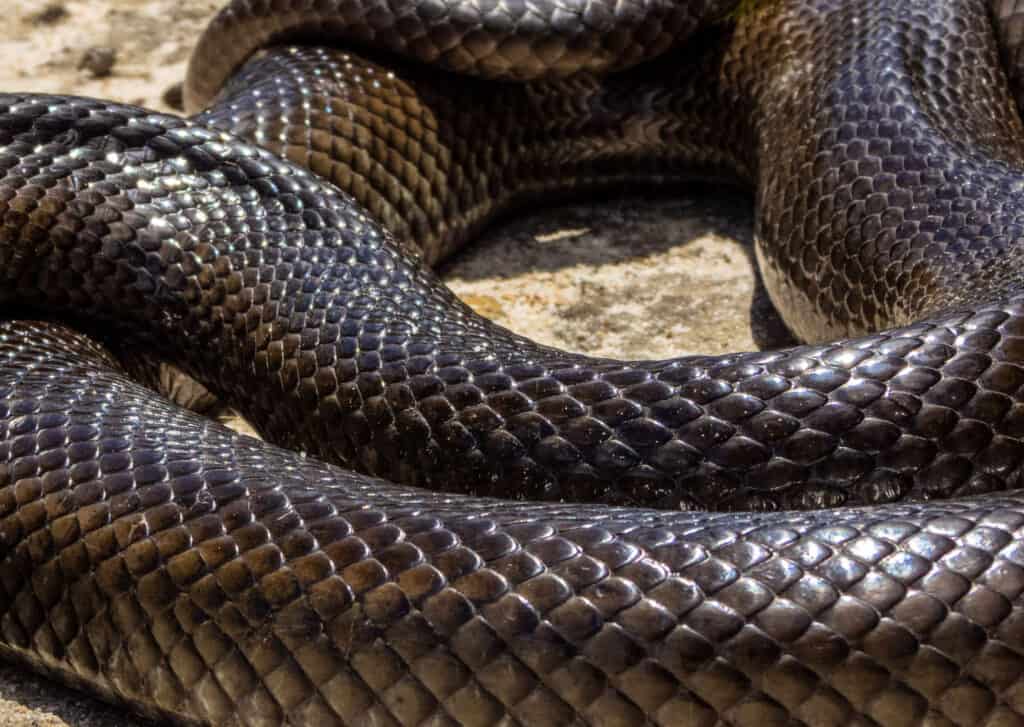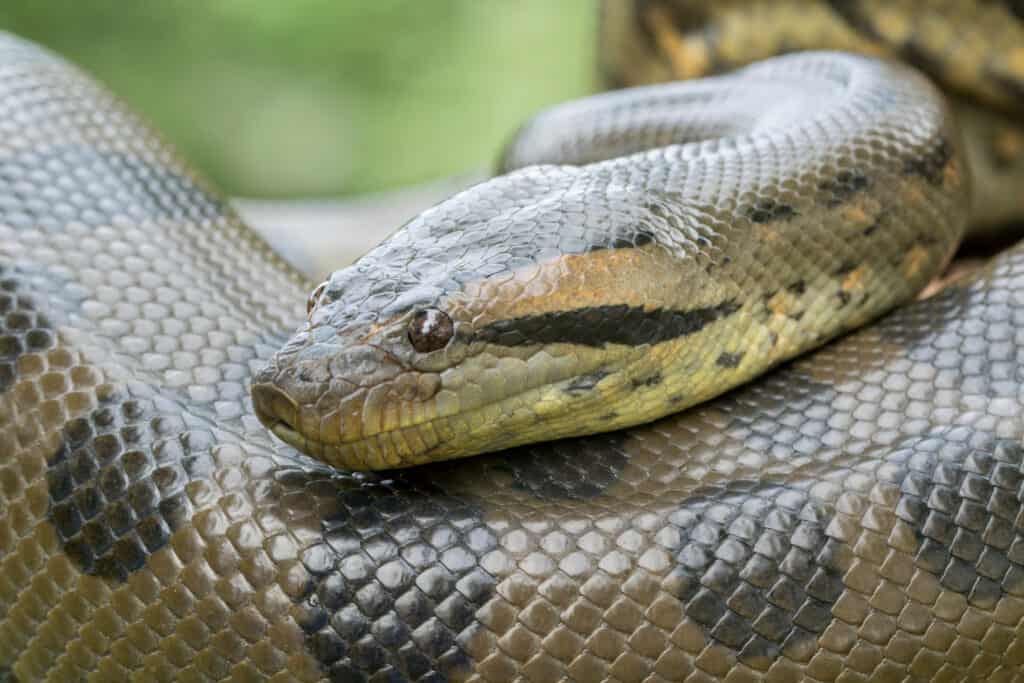Children are curious and rambunctious, often displaying fearless tendencies. In the video at the bottom of this page, you watch a careless kiddo grab hold of a huge black snake’s tail, pulling it closer. Reactions are mixed, with some in awe at the scene while others condemn the parents for allowing the interaction.
Catch The Complete Video Below

A smiling child holds a snake.
©Matt Jeppson/Shutterstock.com
Which Large Snakes Are in Brazil?

Are there any black snakes in Brazil?
©iStock.com/Willem Van Zyl
In the Brazilian rainforests, there are a wide variety of snakes. Some of them are small but there are those that grow large. The green anaconda, for example, is a snake that can grow just over 16 feet long. The females are significantly larger than their male counterparts. They prefer rainforests where they can enjoy plenty of moisture, even submerged in swamps. These snakes use their sharp fangs to take down large prey, including leopards, deer, and capybaras.
Yellow anacondas are also one of the largest in this country. Boa constrictors are a bit smaller, growing up to 13 feet. They may be yellow or red or tanner colored depending on where they live. Their patterns are geometric, and they prefer inhabiting burrows and trees. Although large, they move swiftly and take down prey like wild boars and monkeys. Their bite is something fierce but luckily for any human who gets too close, this snake is non-venomous.

The green anaconda is a snake that can grow just over 16 feet long and can be found in Brazil.
©Mark_Kostich/Shutterstock.com
What Snakes Are Black in Brazil?
The Amazon-banded snake is black with white, orange, and reddish bands throughout its body. It’s native to South America and can be found in countries like Peru, Bolivia, Colombia, and Brazil. The Annellated coral snake is native to the western part of Brazil. These are small snakes, growing up to just over two feet long. Hemprichi’s coral snake is a venomous snake native to South America that has a mostly black body with bands of yellowish-orange and white. Bothrops jararacussu, commonly known in English as the jararacussu, is a highly venomous pit viper species endemic to South America. It is one of the most dreaded snakes in that country and can grow up to 7 feet long. The Bothrops neuwiedi is another highly venomous pit viper species endemic to South America. It is a relatively small snake but has a powerful bite and even more powerful venom.

What happens when a child holds onto a snake? Watch below!
©iStock.com/SerrNovik
Child Holds a Snake’s Tail
In the video below, it’s unclear what type of snake is being featured. But it’s evident it’s quite large. Ideally, it’s non-venomous, as a child has got a hold of it by its tail. The child is dressed in a beige t-shirt without pants or shoes and is casual about the massive black snake. The snake seems unbothered by the tug at its tail and instead wraps itself around a wooden pole to prevent being dragged further away. At the tail end of the video, you can see there’s an adult present, which brings some sense of relief as you take in the unreal sight.
What’s the Proper Way to Handle a Snake?

It’s important to exercise caution when handling a snake, especially one in the wild.
©Janelle Lugge/Shutterstock.com
Is it smart or safe to pick up or handle a snake by its tail? Before we answer that question, it bears mentioning that you should NEVER handle a venomous snake. Leave that to the experts. But there are pet owners of snakes who would regularly handle their own. We assume they would know proper ways of handling these potentially fun reptiles, but for the novices, you should not pick up a snake by the tail. Why? Handling a snake by its tail can damage it, as its tail is a narrower, weaker area, and the snake may wriggle or twist. If the snake is wild or skittish, it’s also possible the snake could turn back on you.
Some believe handling the snake by gripping its head is best. This is not the case either. If gripping it by the head is necessary, it’s suggested to use all your fingers and avoid choking the snake. Otherwise, you’d want to pick the snake up from the middle of its body and support it to alleviate its possible fear of falling. You should use slow steady movements, and allow the snake to move from hand to hand if it desires.
You should not handle a snake that has just eaten, as it can regurgitate. Tools that are used for picking up snakes from terrariums or in the wild include hooks and tongs.
The photo featured at the top of this post is © iStock.com/Willem Van Zyl
Discover the "Monster" Snake 5X Bigger than an Anaconda
Every day A-Z Animals sends out some of the most incredible facts in the world from our free newsletter. Want to discover the 10 most beautiful snakes in the world, a "snake island" where you're never more than 3 feet from danger, or a "monster" snake 5X larger than an anaconda? Then sign up right now and you'll start receiving our daily newsletter absolutely free.
Thank you for reading! Have some feedback for us? Contact the AZ Animals editorial team.







